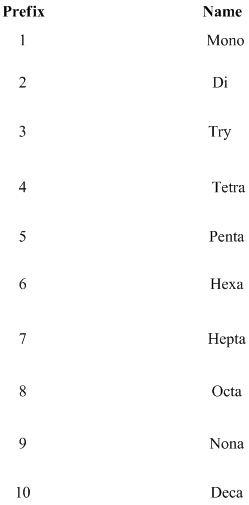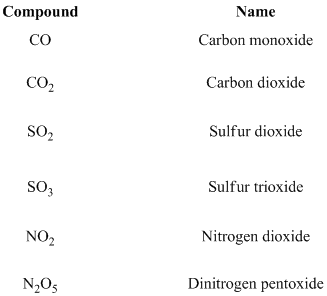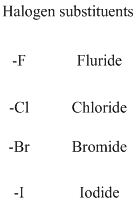
Interpretation:
The name of the molecule should be identified.
Concept introduction:
According to the nomenclature, when two nonmetals are present in the given compound the name of the compound is given as follows, For example, HCl. According to the name of the compound, first give the name for the hydrogen followed by the second element, changing the ending of its name to –ide. Chlorine called as chloride. Therefore HCl is hydrogen chloride. Similarly, HI is hydrogen iodide. SiC is silicon carbide.
One pair of elements to form several different binary molecular compounds. In these cases, using of Greek prefixes to denote the number of atoms of each element present.
Greek prefixes are given below,

If prefix mono substituted is generally omitted for the first element. For example, SO2 is named sulfur dioxide, is not monosulfur dioxide. Moreover, only one atom in a prefix for the first element, no needs to mention mono or di etc. In addition, for ease of pronunciation, we usually eliminate the last letter of a prefix that ends in o or a when naming an oxide. Thus, N2O5 is dinitrogen pentoxide, rather than dinitrogen pentaoxide.

If any halogens are present in the molecule in suffix, the name of the halogens as follows.

Want to see the full answer?
Check out a sample textbook solution
Chapter 5 Solutions
Chemistry: Atoms First
- Please correct answer and don't used hand raitingarrow_forwardPlease correct answer and don't used hand raitingarrow_forwardThe table shows the tensile stress-strain values obtained for various hypothetical metals. Based on this, indicate which material will be the most ductile and which the most brittle. Material Yield strength Tensile strength Breaking strain Breaking strength Elastic modulus (MPa) (MPa) (MPa) (GPa) A 310 340 0.23 265 210 B 100 120 0.40 105 150 с 415 550 0.15 500 310 D 700 850 0.14 720 210 E - Non-effluence fracture 650 350arrow_forward
- Please correct answer and don't used hand raiting and don't used Ai solutionarrow_forwardPlease correct answer and don't used hand raitingarrow_forwardConsider the following Figure 2 and two atoms that are initially an infinite distance apart, x =00, at which point the potential energy of the system is U = 0. If they are brought together to x = x, the potential energy is related to the total force P by dU dx = P Given this, qualitatively sketch the variation of U with x. What happens at x=x? What is the significance of x = x, in terms of the potential energy? 0 P, Force 19 Attraction Total Repulsion x, Distance Figure 2. Variation with distance of the attractive, repulsive, and total forces between atoms. The slope dP/dx at the equilibrium spacing xe is proportional to the elastic modulus E; the stress σb, corresponding to the peak in total force, is the theoretical cohesive strength.arrow_forward
- Denote the dipole for the indicated bonds in the following molecules. H3C ✓ CH3 B F-CCl 3 Br-Cl H3C Si(CH3)3 wwwwwww OH НО. HO HO OH vitamin C CH3arrow_forwardFor the SN2 reaction, draw the major organic product and select the correct (R) or (S) designation around the stereocenter carbon in the organic substrate and organic product. Include wedge-and-dash bonds and draw hydrogen on a stereocenter. Η 1 D EN Select Draw Templates More C H D N Erasearrow_forwardQ9: Explain why compound I is protonated on O while compound II is protonated on N. NH2 NH2 I IIarrow_forward
 Introduction to General, Organic and BiochemistryChemistryISBN:9781285869759Author:Frederick A. Bettelheim, William H. Brown, Mary K. Campbell, Shawn O. Farrell, Omar TorresPublisher:Cengage Learning
Introduction to General, Organic and BiochemistryChemistryISBN:9781285869759Author:Frederick A. Bettelheim, William H. Brown, Mary K. Campbell, Shawn O. Farrell, Omar TorresPublisher:Cengage Learning World of Chemistry, 3rd editionChemistryISBN:9781133109655Author:Steven S. Zumdahl, Susan L. Zumdahl, Donald J. DeCostePublisher:Brooks / Cole / Cengage Learning
World of Chemistry, 3rd editionChemistryISBN:9781133109655Author:Steven S. Zumdahl, Susan L. Zumdahl, Donald J. DeCostePublisher:Brooks / Cole / Cengage Learning

